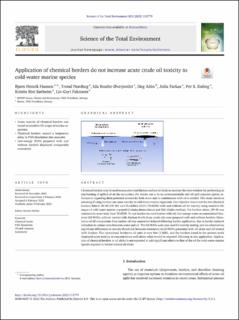| dc.contributor.author | Hansen, Bjørn Henrik | |
| dc.contributor.author | Nordtug, Trond | |
| dc.contributor.author | Øverjordet, Ida Beathe | |
| dc.contributor.author | Altin, Dag | |
| dc.contributor.author | Farkas, Julia | |
| dc.contributor.author | Daling, Per Snorre | |
| dc.contributor.author | Sørheim, Kristin Rist | |
| dc.contributor.author | Faksness, Liv Guri | |
| dc.date.accessioned | 2022-08-05T12:40:28Z | |
| dc.date.available | 2022-08-05T12:40:28Z | |
| dc.date.created | 2022-02-14T11:10:35Z | |
| dc.date.issued | 2022 | |
| dc.identifier.citation | Science of the Total Environment. 2022, 823 1-9. | en_US |
| dc.identifier.issn | 0048-9697 | |
| dc.identifier.uri | https://hdl.handle.net/11250/3010379 | |
| dc.description.abstract | Chemical herders may be used to sequester and thicken surface oil slicks to increase the time window for performing in situ burning of spilled oil on the sea surface. For herder use to be an environmentally safe oil spill response option, information regarding their potential ecotoxicity both alone and in combination with oil is needed. This study aimed at assessing if using herders can cause toxicity to cold-water marine organisms. Our objective was to test the two chemical herders Siltech OP-40 (OP-40) and ThickSlick-6535 (TS-6535) with and without oil for toxicity using sensitive life stages of cold-water marine copepod (Calanus finmarchicus) and fish (Gadus morhua). For herders alone, OP-40 was consistently more toxic than TS-6535. To test herders in combination with oil, low-energy water accommodated fractions (LE-WAFs, without vortex) with Alaskan North Slope crude oils were prepared with and without herders. Dissolution of oil components from surface oil was somewhat delayed following herder application, due to herder-induced reduction in contact area between water and oil. The LE-WAFs were also used for toxicity testing, and we observed no significant differences in toxicity thresholds between treatments to LE-WAFs generated with oil alone and oil treated with herders. The operational herder-to-oil ratio is very low (1:500), and the herders tested in the present work displayed acute toxicity at concentrations well above what would be expected following in situ application. Application of chemical herders to oil slicks is not expected to add significant effects to that of the oil for cold-water marine species exposed to herder-treated oil slicks. | en_US |
| dc.language.iso | eng | en_US |
| dc.publisher | Elsevier | en_US |
| dc.rights | Navngivelse 4.0 Internasjonal | * |
| dc.rights.uri | http://creativecommons.org/licenses/by/4.0/deed.no | * |
| dc.subject | Ecotoxicity | en_US |
| dc.subject | Oil spill response | en_US |
| dc.subject | PAH dissolution | en_US |
| dc.subject | Chemical herder | en_US |
| dc.title | Application of chemical herders do not increase acute crude oil toxicity to cold-water marine species | en_US |
| dc.title.alternative | Application of chemical herders do not increase acute crude oil toxicity to cold-water marine species | en_US |
| dc.type | Peer reviewed | en_US |
| dc.type | Journal article | en_US |
| dc.description.version | publishedVersion | en_US |
| dc.rights.holder | © 2022 The Authors. Published by Elsevier B.V. | en_US |
| dc.source.pagenumber | 1-9 | en_US |
| dc.source.volume | 823 | en_US |
| dc.source.journal | Science of the Total Environment | en_US |
| dc.identifier.doi | 10.1016/j.scitotenv.2022.153779 | |
| dc.identifier.cristin | 2001228 | |
| dc.source.articlenumber | 153779 | en_US |
| cristin.ispublished | true | |
| cristin.fulltext | original | |
| cristin.qualitycode | 2 | |

